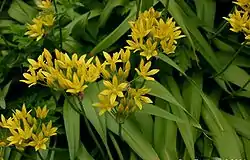Allium moly
Allium moly, also known as yellow garlic,[4] golden garlic and lily leek, Is a species of flowering plant in the genus Allium, which also includes the flowering and culinary onions and garlic. A bulbous herbaceous perennial from the Mediterranean,[5][6] it is edible and also used as a medicinal and ornamental plant.[7][8]
| Golden garlic | |
|---|---|
 | |
| Allium moly | |
| Scientific classification | |
| Kingdom: | Plantae |
| Clade: | Tracheophytes |
| Clade: | Angiosperms |
| Clade: | Monocots |
| Order: | Asparagales |
| Family: | Amaryllidaceae |
| Subfamily: | Allioideae |
| Genus: | Allium |
| Species: | A. moly |
| Binomial name | |
| Allium moly | |
| Synonyms[3] | |
| |
Occurrence and appearance
Allium moly is primarily found in Spain and Southern France with additional populations in Italy, Austria, Czech Republic, Algeria, and Morocco.[3][9][10][11]
With lance-shaped grey-green leaves up to 30 cm long, in early summer it produces masses of star-shaped bright yellow flowers in dense umbels. The cultivar ‘Jeannine’ has gained the Royal Horticultural Society’s Award of Garden Merit.[4]
Variants
- formerly included[3]
- Allium moly var. ambiguum, now called Allium roseum
- Allium moly subsp. massaessylum, now called Allium massaessylum
- Allium moly var. stamineum, now called Allium stamineum
- Allium moly var. xericiense, now called Allium scorzonerifolium
See also
- Moly (herb), mentioned in The Odyssey, from which Linnaeus took the species' name
References
- Draper Munt, D. (2011). Allium moly. The IUCN Red List of Threatened Species 2011: e.T172220A6852079. doi:10.2305/IUCN.UK.2011-1.RLTS.T172220A6852079.en Downloaded on 05 January 2019.
- The International Plant Names Index
- Kew World Checklist of Selected Plant Families
- "RHS Plantfinder - Allium moly 'Jeannine'". Royal Horticultural Society. 1993. Retrieved 5 January 2018.
- Tropicos, Allium moly L.
- Maire, R. (1958). Flore de l'Afrique du Nord 5: 1-307. Paul Lechevalier, Paris
- Missouri Botanical Garden Gardening Help: Allium moly
- Plants For A Future: Allium moly
- Altervista Flora Italiana
- Hohla, M. (2011). Zwei Funde der Kleine Seerose (Nymphaea candida) sowie weitere Beiträge zur Kenntnis der Flora von Oberösterreich. Stapfia 95: 141-161.
- Danihelka, J. Chrtek, J. & Kaplan, Z. (2012). Checklist of vascular plants of the Czech Republic. Preslia. Casopsi Ceské Botanické Spolecnosti 84: 647-811.
| Wikimedia Commons has media related to Allium moly. |
This article is issued from Wikipedia. The text is licensed under Creative Commons - Attribution - Sharealike. Additional terms may apply for the media files.
